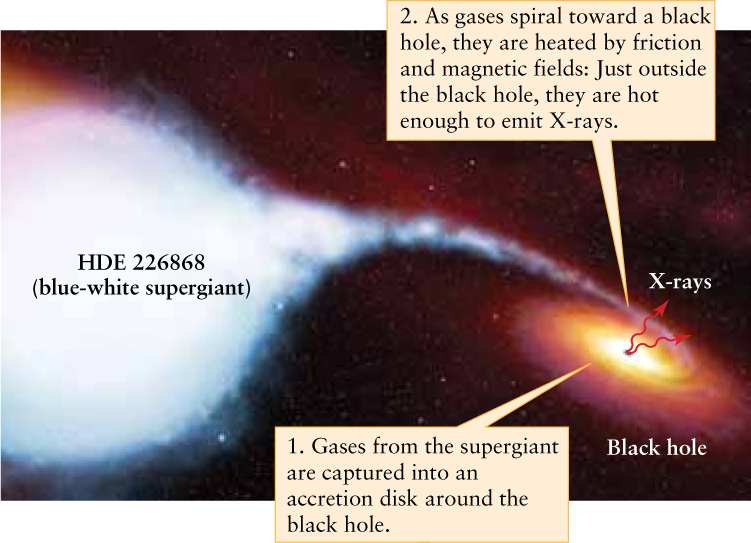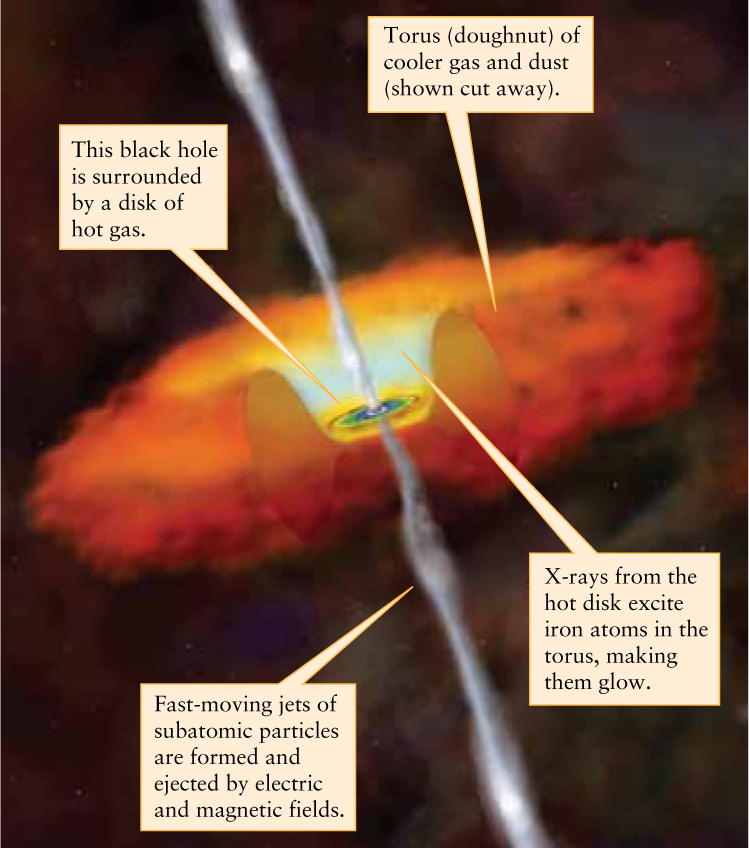21-3 Certain binary star systems probably contain black holes
 Finding black holes is a difficult business. Because light cannot escape from inside the black hole, you cannot observe one directly in the same way that you can observe a star or a planet. The best you can hope for is to detect the effects of a black hole’s powerful gravity.
Finding black holes is a difficult business. Because light cannot escape from inside the black hole, you cannot observe one directly in the same way that you can observe a star or a planet. The best you can hope for is to detect the effects of a black hole’s powerful gravity.
One key to detecting black holes is to search for the radiation emitted by material as it falls into a hole
Close binary star systems offer a unique way to find stellar-mass black holes. Imagine that one of the stars in a binary system evolves into a black hole. The binary system is not destroyed when one star undergoes a supernova to produce a black hole, leaving the binary partner to aid in the detection of the black hole itself. If the black hole orbits close enough to the remaining ordinary star, tidal forces can draw matter from the star onto the black hole. Fortunately, we can detect this “stolen” matter as it accretes around the black hole.
Given the tremendous strength of gravity around stellar-mass black holes, their accreted matter would be compressed and heated up to very high temperatures before being sucked into the black hole. In fact, the temperatures are so high that the accreted matter would give off X-rays, so the search for these black holes is conducted with X-ray telescopes.
The Case of Cygnus X-1
The first sign of such emissions from a binary system with a black hole came shortly after the launch of the Uhuru X-ray–detecting satellite in 1971. Astronomers became intrigued with an X-ray source designated Cygnus X-1 (Figure 21-10). This source is quite unlike pulsating X-ray sources, which emit regular bursts of X-rays every few seconds (see Section 21-8). Instead, the X-ray emissions from Cygnus X-1 are highly variable and irregular; they flicker on timescales as short as one-hundredth of a second.

Is Cygnus X-1 big, like a regular star, or very compact, like a stellar remnant core? Amazingly, this can be answered very well without directly seeing the physical extent of Cygnus X-1. One of the fundamental concepts in physics is that nothing can travel faster than the speed of light (recall Section 21-1). Because of this limitation, different parts of an object cannot flicker in unison faster than the time required for light to travel across the object. Because light travels 3000 km in a hundredth of a second, Cygnus X-1 can be no more than 3000 km across, or about a quarter the size of Earth. This places a fundamental upper limit on the size of Cygnus X-1 and clearly rules it out as a star.
Cygnus X-1 occasionally emits bursts of radio emission, and in 1971 radio astronomers used these bursts to show that the source was nearly at the same location in the sky as the star HDE 226868. Spectroscopic observations revealed that HDE 226868 is a B0 supergiant with a surface temperature of about 31,000 K. Such stars do not emit significant amounts of X-rays, so HDE 226868 alone cannot be the X-ray source Cygnus X-1. Because binary stars are very common, astronomers began to suspect that the visible star and the X-ray source are in orbit about each other.
Further spectroscopic observations soon showed that the lines in the spectrum of HDE 226868 shift back and forth with a period of 5.6 days; this is the Doppler shift as illustrated in Figure 17-23. The clear implication is that HDE 226868 and Cygnus X-1 are the two members of a binary star system. From what we know about the masses of other supergiant stars, HDE 226868 is estimated to have a mass of roughly 20 M⊙.
The rest of the puzzle involves estimating the mass of Cygnus X-1 based on the properties of the binary system. For example, the magnitude of the measured Doppler shifts—how much the spectral lines of the ordinary star shift back and forth—are influenced by the mass of Cygnus X-1. After decades of careful observation, the mass of Cygnus X-1 is estimated to be 14.8 M⊙. Keep in mind that Cygnus X-1 is very compact—smaller than Earth. With a maximum possible white dwarf mass of 1.4 M⊙, a maximum neutron star mass of 2–3 M⊙, it is very likely that Cygnus X-1 is a 14.8-M⊙ black hole.
If Cygnus X-1 does contain a black hole, the X-rays do not come from the black hole itself. Gas captured from HDE 226868 goes into orbit about the hole, forming an accretion disk about 4 million km in diameter (see Figure 21-10). As material in the disk gradually spirals in toward the hole, friction heats the gas to temperatures approaching 2 × 106 K. In the final 200 km above the hole, these extremely hot gases emit the X-rays that our satellites detect. Presumably the X-ray flickering is caused by small hot spots on the rapidly rotating inner edge of the accretion disk. In this way, the black hole’s existence is revealed by hot gases just before they plunge to oblivion.
But is there really a black hole at the center of Cygnus X-1? With Cygnus X-1 so far away (about 6,100 ly), astronomers do not have the capability to detect the emission signatures unique to black holes expected near the event horizon. Furthermore, the size constraints mentioned above for Cygnus X-1 do not place its mass of 14.8 M⊙ within its event horizon. Nonetheless, theoretical calculations provide two compelling results. First, there is no known type of object or state of matter that could contain 14.8 M⊙ within the observed upper size limit of Cygnus X-1. Second, even if the observed 14.8 M⊙ were due to some unknown object (or collection of objects), it would very quickly collapse into a black hole anyway. More than 40 years after its discovery, astronomers think the case for a black hole at the center of Cygnus X-1 is very strong.
CONCEPT CHECK 21-7
There are stars that are 14.8 M⊙, so why is the mass found in Cygnus X-1 considered a black hole?
Stars do not emit strongly in X-rays, as Cygnus X-1 does. More importantly, fast variations in the X-ray brightness tell us that the mass of Cygnus X-1 is smaller than Earth—far too small for any type of star or other object.
Other Black Hole Candidates
Astronomers have found more than 20 other black hole candidates like Cygnus X-1. All are compact X-ray sources orbiting ordinary stars in a spectroscopic binary system. One of the best candidates is V404 Cygni in the constellation Cygnus. Doppler shift measurements reveal that as the visible star moves around its 6.47-day orbit, its radial velocity (see Section 17-10) varies by more than 400 km/s. These data indicate a black hole mass of 12 M⊙ for the unseen companion of the visible star. It is probably impossible for a neutron star to be more massive than 3 M⊙, so V404 Cygni must almost certainly be a black hole.

Another particularly convincing case is the flickering X-ray source A0620-00; at only 3000 ly away, it is the black hole candidate closest to Earth. (The A refers to the British satellite Ariel 5, which discovered the source; the numbers denote its position in the sky.) The visible companion to A0620-00 is an orange K5 mainsequence star called V616 Monocerotis, which orbits the X-ray source every 7.75 hours. Because this star is relatively faint, it is possible to observe the shifting spectral lines from both the visible companion and the X-ray source as they orbit each other. With this more complete information about the orbits, astronomers have determined the black hole mass of A0620-00 to be about 11 M⊙.
Astronomers have seen jets of hot, glowing material extending several light-years from some black hole candidates. The ejected material emerges from the vicinity of the black hole at speeds approaching the speed of light. It is thought that these jets are formed by strong electric and magnetic fields in the material around a rotating black hole, much as occurs for rotating protostars (see Figure 18-16) and for rotating neutron stars (see Figure 20-29). Figure 21-11 is an artist’s impression of the immediate vicinity of such a rotating black hole. (We will discuss the curious features of rotating black holes in Section 21-7.)
If there really are black holes in close binary systems, how did they get there? One possibility already mentioned is that one member of the binary explodes as a Type II supernova, leaving a burned-out core whose mass exceeds 3 M⊙. This core undergoes gravitational collapse to form a black hole.
A white dwarf or a neutron star in a binary system could also become a black hole if it accretes enough matter from its companion star. This transformation can occur when the companion star becomes a red giant and dumps a significant part of its mass over its Roche lobe (see Figure 19-21b).
Finally, another possibility is two dead stars coalescing to form a black hole. For example, imagine two neutron stars orbiting each other, like the binary system discussed Section 21-2. Because the two stars emit gravitational radiation, they gradually spiral in toward each other and can eventually merge. If their total mass exceeds 2 to 3 M⊙, the entire system may become a black hole.